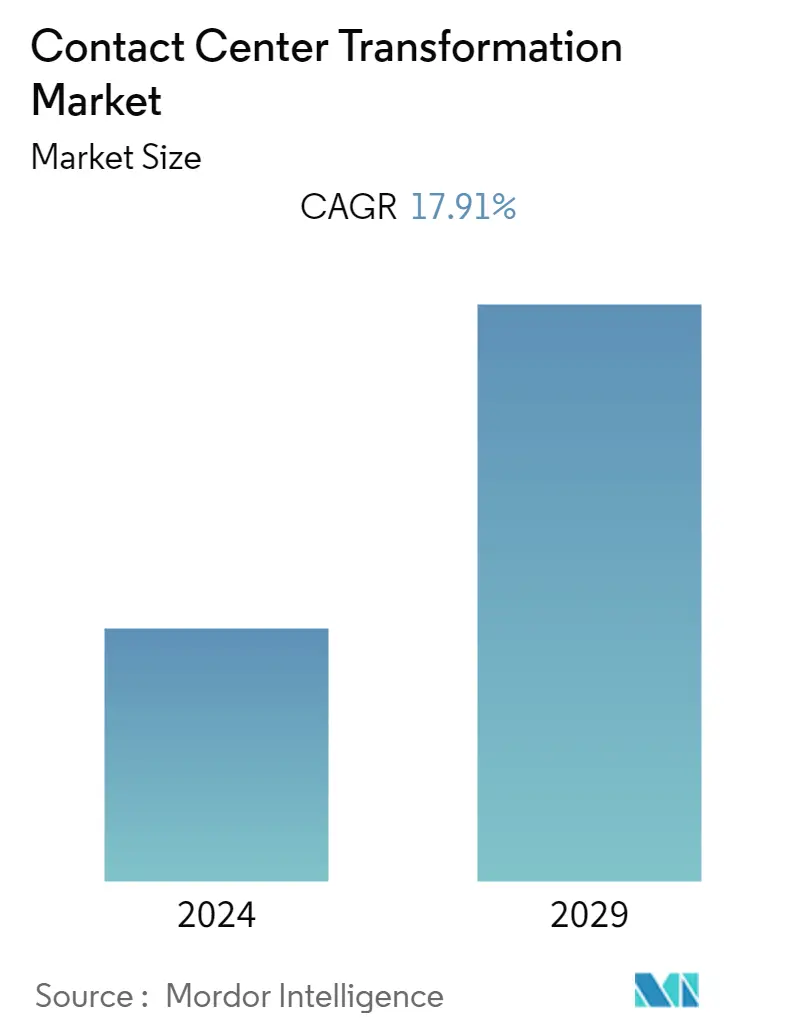Market Size of Contact Center Transformation Industry

| Study Period | 2019 - 2029 |
| Base Year For Estimation | 2023 |
| CAGR | 17.91 % |
| Fastest Growing Market | Asia Pacific |
| Largest Market | North America |
| Market Concentration | Low |
Major Players
*Disclaimer: Major Players sorted in no particular order |
Contact Center Transformation Market Analysis
The global contact center transformation market is expected to register a CAGR of 17.91% during the forecast period. As the cloud-based infrastructure has been digitally transforming the contact centers, flexibility and scalability are added. Benefits, such as the rapid expansion of resources to handle peaks during holiday seasons and scale back during other seasons, have been considered a crucial stage for most retailers. With no additional investments required toward infrastructure or management costs to manage the peak loads, such a digital outlook has been witnessed to transform contact centers increasingly.
- Businesses use automation modules to replace high-cost interaction channels, such as chatbots, with low-cost automated channels. Companies also utilize the interactive voice response (IVR) module, which enables operators to handle high call volumes. Furthermore, this module assists agents in providing good customer support by integrating databases, automatic speech recognition (ASR), and text-to-speech (TTS). This module also verifies callers so that they are routed to the appropriate contact center agent.
- The emerging trend of deploying Artificial Intelligence (AI) technology to enhance an agent's abilities to be more effective and efficient has been gaining traction. After being used to automate routine tasks, it ensures that human agents can better focus on escalated issues rather than mundane tasks.
- Businesses all over the world prefer cloud-based contact center solutions to on-premise solutions because of their ability to scale services. Cloud solutions are intended to connect agents to centralized contact center applications while also providing employees with a secure intranet to collaborate and communicate with one another.
- Moreover, cloud-based solutions can also provide detailed information about agents and customers that executives need help tracking with on-premise solutions. For instance, according to a RingCentral, Inc. study, switching to cloud-based solutions can help improve customer call answer rates by around 5% while decreasing the Average Speed of Answer (ASA) by up to 50%.
- Customer satisfaction is the primary goal of contact center performance because effective customer experience management drives immediate revenue and long-term success. Transformation automation solutions assist firms in improving the quality and efficacy of client inquiries while providing quick customer responses. Furthermore, an integrated automation solution connects the apps and systems in a single interface, allowing agents to create a unified knowledge base that offers real-time relevant data. This frees agents from handling manual, repetitive activities and lets them focus on improving their customer-centric abilities.
- For instance, a study conducted by Salesforce.com, Inc. states that approximately 84% of customers value a company's experience as much as its products and services. Businesses have also realized that better customer service can help boost profits. As a result, enterprises are aggressively adopting contact center solutions to improve customer service, thereby contributing to market growth.
- In automated customer service, chatbots respond to consumer issues such as buying, billing, product kinds, etc. However, certain situations go well beyond that, necessitating the use of a human agent to comprehend, negotiate, and discover a solution, and integration of new solutions with legacy systems is the challenge in the market.
- The COVID-19 outbreak is expected to have a positive and negative influence both on the market. The positive impact of COVID-19 is expected to fuel the growth of digitally enhanced contact centers. Call volumes at contact centers have grown as a result of the epidemic. Furthermore, some contact centers have maintained their vital interaction facilities, driving the demand for automation technologies. The market is expected to increase due to global digital transformation after the pandemic.
- Furthermore, the market saturation and infrastructure challenges to enable work-from-home created additional challenges worldwide that were hit hard by the COVID-19 pandemic lockdowns. Job creation in the global contact center industry has decreased by 36%.
- Moreover, most contact center industry employees quickly transitioned from facility-based to work-from-home. Despite the impact of the COVID-19 pandemic, the United States led overall job creation with 102 projects announced, totaling 36,196 jobs, a decrease of 48.2% from pre-COVID effects. The Latin America and Caribbean region was the second most active region, with 45 projects creating an estimated 29,250 jobs, a 21.4% decrease from the previous year.
Contact Center Transformation Industry Segmentation
The study analyses the demand and adoption of contact center software and services solutions across key industry verticals. The study provides a detailed assessment of the transformation of contact centers over the last decade from single-channel (call) entities to omnichannel-based centers with advanced capabilities, mainly driven by the growing adoption of cloud-based solutions and technological advancements. The impact of COVID-19 on the overall contact center industry and its effect on the various deployment types are comprehensively analyzed in the study. Segmentation by deployment considers on-premise and hosted sub-segments, where hosted also realizes cloud based-deployments.
The contact center transformation market is segmented by type (intelligent call routing, workforce performance optimization, dialers, interactive voice response, computer telephony integration, analytics, and reporting, services (consulting and managed services), by deployment (on-premise, hosted), organization size ( small and medium enterprises, large enterprises), by end-user industry ( banking, financial services, and insurance (BFSI), IT and telecom, media and entertainment, retail and consumer, healthcare), and by geography (North America, Europe, Asia-pacific, Middle East & Africa, and Latin America). The market sizes and forecasts are provided in terms of value (USD million) for all the above segments.
| By Type | |
| Intelligent Call Routing | |
| Workforce Performance Optimization | |
| Dialers | |
| Interactive Voice Response | |
| Computer Telephony Integration | |
| Analytics and Reporting | |
| Services (Consulting and Managed Services) |
| By Deployment | |
| On-Premise | |
| Hosted |
| By Organization Size | |
| Small and Medium Enterprises | |
| Large |
| By End-user Industry | |
| Banking, Financial Services, and Insurance (BFSI) | |
| IT and Telecom | |
| Media and Entertainment | |
| Retail and Consumer | |
| Healthcare | |
| Other End-user Industries |
| By Geography | |
| North America | |
| Europe | |
| Asia-Pacific | |
| Latin America | |
| Middle East & Africa |
Contact Center Transformation Market Size Summary
The contact center transformation market is experiencing significant growth, driven by the adoption of cloud-based solutions and automation technologies. These advancements offer businesses the flexibility and scalability needed to manage varying call volumes without the need for substantial infrastructure investments. The integration of automation modules, such as chatbots and interactive voice response systems, has enabled companies to reduce costs and improve efficiency by handling high call volumes and enhancing customer support. The deployment of artificial intelligence (AI) is also gaining traction, as it helps agents focus on complex issues by automating routine tasks. This shift towards digital transformation is further supported by the increasing preference for cloud-based solutions over on-premise systems, as they provide better scalability and detailed insights into agent and customer interactions.
The market is characterized by intense competition, with major players like RingCentral Inc., NICE Systems Inc., 8x8 Inc., Genesys Telecommunications Laboratories Inc., and Five9 Inc. leading the charge through strategic partnerships and technological advancements. The COVID-19 pandemic has accelerated the demand for digitally enhanced contact centers, although it also posed challenges such as market saturation and infrastructure issues. North America remains a prominent region for contact center solutions, with a steady increase in the number of contact centers and investments in emerging technologies. The focus on personalized customer experiences and the integration of intelligent call routing systems are key trends shaping the market, as businesses strive to improve customer satisfaction and drive revenue growth.
Contact Center Transformation Market Size - Table of Contents
-
1. MARKET INSIGHTS
-
1.1 Market Overview
-
1.2 Industry Attractiveness - Porter's Five Forces Analysis
-
1.2.1 Bargaining Power of Suppliers
-
1.2.2 Bargaining Power of Consumers
-
1.2.3 Threat of New Entrants
-
1.2.4 Threat of Substitute Products
-
1.2.5 Intensity of Competitive Rivalry
-
-
-
2. MARKET SEGMENTATION
-
2.1 By Type
-
2.1.1 Intelligent Call Routing
-
2.1.2 Workforce Performance Optimization
-
2.1.3 Dialers
-
2.1.4 Interactive Voice Response
-
2.1.5 Computer Telephony Integration
-
2.1.6 Analytics and Reporting
-
2.1.7 Services (Consulting and Managed Services)
-
-
2.2 By Deployment
-
2.2.1 On-Premise
-
2.2.2 Hosted
-
-
2.3 By Organization Size
-
2.3.1 Small and Medium Enterprises
-
2.3.2 Large
-
-
2.4 By End-user Industry
-
2.4.1 Banking, Financial Services, and Insurance (BFSI)
-
2.4.2 IT and Telecom
-
2.4.3 Media and Entertainment
-
2.4.4 Retail and Consumer
-
2.4.5 Healthcare
-
2.4.6 Other End-user Industries
-
-
2.5 By Geography
-
2.5.1 North America
-
2.5.2 Europe
-
2.5.3 Asia-Pacific
-
2.5.4 Latin America
-
2.5.5 Middle East & Africa
-
-
Contact Center Transformation Market Size FAQs
What is the current Contact Center Transformation Market size?
The Contact Center Transformation Market is projected to register a CAGR of 17.91% during the forecast period (2024-2029)
Who are the key players in Contact Center Transformation Market?
RingCentral Inc., NICE Systems Inc., 8x8 Inc., Genesys Telecommunications Laboratories Inc. and Five9 Inc. are the major companies operating in the Contact Center Transformation Market.

